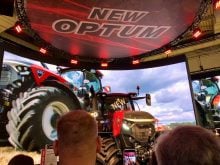It couldn’t be right.
Chickens clucking on the third floor of one of Calgary’s poshest downtown hotels?
There they were, larger-than-life animatronic chickens from the farm of Ontario farmer Jerry Howell.
The clucking, singing chickens were on display at the North American Farm Direct conference in Calgary, a convention for those interested in learning more about how to entice customers looking for fresh products from the farm.
“This is my gimmick,”said the 40-year-old computer and electronics technician turned pumpkin farmer.
Read Also

Agritechnica Day 2: The future of tractor power, building quicker crop apps and large farms and tech
Agritechnica Day 2: The future of tractor power, building quicker crop apps with Syngenta and large farms and tech
Howell sells about 50,000 pumpkins in a little more than a month from his farm in Ontario’s Niagara peninsula. He also sells corn and squash.
Most of his business is conducted in autumn because people want pumpkins for Thanksgiving and Halloween.
“About 80 percent of our income is earned in 11 days,” he said.
After 15 years on the farm, Howell knew he needed added attractions to hold the customers and get them to spend more on family oriented activities like hay rides and a corn maze.
“People are coming to my farm, not just to buy pumpkins but to see all the crazy stuff,” he said.
He designed the concept of singing chickens, frogs and skeletons and works with a puppeteer, carpenter and engineer to create them. The figures are also sold to farms involved with direct sales and agritourism.
His grandfather started the farm in 1942 and used it to pasture cattle. His father took over and made it a chicken and hog operation.
As a nine-year-old, Howell started raising and selling pumpkins, which paid his way through technical school. They have become the main business since the livestock was dispersed.
Howell starts the pumpkins from seed in a greenhouse each spring and designed a planter to reduce hand work in the field.
Making a living off agriculture is becoming increasingly difficult in his area about a one hour drive from Toronto.
He and his neighbours compete against Toronto commuters seeking their own little place in the country, municipal land-use quarrels and deer that have developed a taste for pumpkins.
Fifteen years ago, a few deer foraged among the new plants. In recent years Howell has counted as many as 100 deer eating the vines and pumpkins in the 35 acre field.
But he can’t afford wildlife fencing and he argues the municipality should pay for it because the land is beside a forest designated an environmental preserve.
He also needs more land to rotate the pumpkins with other crops for better quality products, but the price and availability of land make it almost impossible to find enough.
Increasing country residential development and ensuing quarrels with municipal authorities make it difficult to find suitable farm land.
These days Howell’s farm is worth more for its real estate value than for agriculture worth. He is determined to maintain the farm.
“I could cash out but I refuse,”he said.















